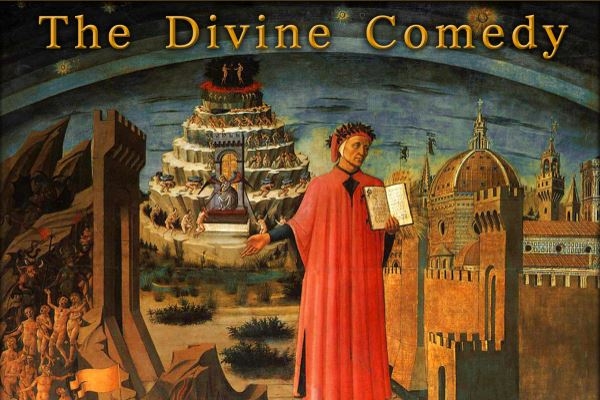By: Walter Cambra
The author of The Divine Comedy, Dante Alighieri, employs the astrological zodiacal wheel in his work and refers to the zodiac as “the twelve-toothed cogwheel” (Purgatorio, Canto IV, v. 64). Dante mentions that his realization of having strayed from the true way came in his thirty-fifth year as “the sun was climbing Aries” (Inferno, Canto I, vv. 37-39).
Dante employs the signs of the zodiac in a very specific manner which serves his occult theme of polarities. Only six of the twelve signs are found in the The Divine Comedy. Two signs are accented in each of its three sections, namely, “The Inferno,” “The Purgatorio” and “The Paradisio.” These six signs are Aries (Inferno, Canto I, v. 38), Aquarius (Inferno, Canto XXIX, v. 2), Sagittarius (Purgatorio, Canto II, vv. 55-56), Libra (Purgatorio, Canto XXVII, vv. 1-3), Leo (Paradisio, Canto XXI, v. 14) and Gemini (Paradisio, Canto XXII, vv. 110-111).
Dante’s usage of the zodiacal wheel serves as a dramatic as well as structural and architectonic feature in organizing and weaving his literary edifice. Aries has a polarity with Libra; Aquarius with Leo and Sagittarius with Gemini. Aries, Aquarius and Libra are mentioned explicitly, while he merely alludes to Sagittarius, Leo. and Gemini.
The twelve signs of the astrological zodiacal wheel are normally listed in the following counter-clockwise sequence: Aries Taurus, Gemini, Cancer, Leo, Virgo, Libra Scorpio, Sagittarius, Capricorn, Aquarius and Pisces. Dante, however, begins with Aries and moves through Pisces into Aquarius (clockwise)! Next he moves from Aquarius through Capricorn into Sagittarius; from Sagittarius through Scorpio into Libra and Libra through Virgo into Leo. Finally, he moves from Leo through Cancer into Gemini.
Dante’s reverse movement from Aries into Pisces and on through the zodiac rather than from Aries into Taurus is fundamental to his quest/journey through the darkness back toward the ‘true way’ or light.
It is not only dramatic but iconic (regarding the esoterica of the astrological signs) that Dante ends his journey in Gemini. There he is reunited with his beloved Beatrice. Gemini is the sign of the Eternal Twins as well as Dante’s Sun sign (Paradisio, Canto XXII, vv. 110-117). Gemini and Virgo are also ruled by the only androgynous planet, namely, Mercury.
The author, Walter Cambra, has an MA in Philosophy from San Francisco State University (1993). He is the Frater of the Ancient and Mystical Order Rose+Cross (AMORC), Frater: Order Summum Bonum. He has had several scholarly papers delivered and read at the Bram Stoker International Summer School in Clontarf, Ireland. He is an AFA certified astrologer and has had numerous publications in Today’s Astrologer and elsewhere. His astrology is primarily influenced by the esoteric practices within theosophy, but he also explores more modern techniques, including the use of the asteroid Chiron.



